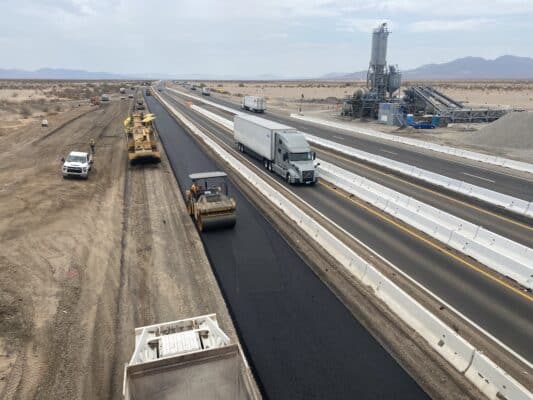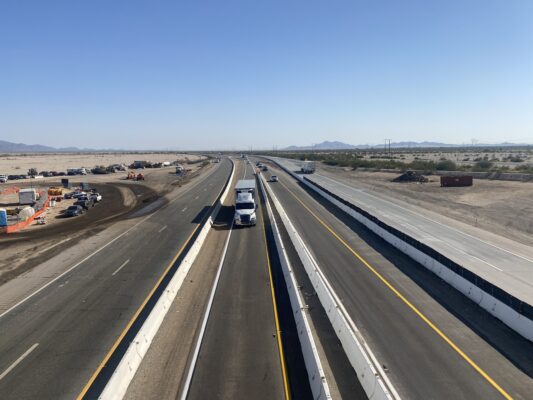|
Getting your Trinity Audio player ready...
|
Christy Connors packed all of her belongings into a car and headed west. It was 1991, long before the era of Google Maps, or even MapQuest. She used an old-fashioned atlas to find her way from Pennsylvania to California to take her first job out of college with Caltrans. Before then, Connors had never even been to the Golden State. More than 30 years later she is building and renovating its biggest interstate highways.
Caltrans is California’s Department of Transportation. Based in the state capital of Sacramento, the department aims to “provide a safe, sustainable, integrated, and efficient transportation system to enhance California’s economy and livability.” It is divided into 12 districts, whose workers manage all aspects of highways, expressways, and freeways.

When HR teams at Caltrans recruited Connors from Virginia Tech, they sent her a VHS tape about the High Sierras. It showed the trees, mountains, trails, and fishing holes of Inyo County–Caltrans District 9. It was dusk when Connors’ car finally arrived in Bishop, California, a town she remembers driving by that now has 3,820 residents.
Fast-forward to today, Connors is the department’s deputy district director for construction in District 8. In that role, she manages huge projects like the $780 million, multi-year endeavor to redo 70 miles of Interstate 10 between Palm Springs and the Arizona state line. The program, called Fix-it-First, uses state and federal fundings to rebuild California by focusing on upgrading roads and enhancing safety.
“I had the right leadership and management skills to take on a new challenge.”
Christy Connors
But Connors didn’t start out in construction at Caltrans. In fact, she spent the first part of her engineering career on the design side. After a mandatory rotation program took the civil engineer through stints in design, construction, and electives like surveying, she transferred to District 8 to design for San Bernardino and Riverside counties.
Today, Connors leads 300 employees. Together, they administer construction contracts after they go out to bid, and now the team has 50 projects that total more than 1 billion dollars. Although it’s a large division that also includes inspection, labor compliance, and disadvantaged business goals, Connors says her overall goal is simple. “We are here to get jobs built and open to the public as we serve the people of California,” she explains.
From 1995 to 2019, Connors worked diligently on projects both large and small. In 2008, Connors became design deputy, and during her tenure in leadership, the team always delivered 100 percent of its program, which has anywhere from 12 to 36 projects annually.
In doing so, she’s bridging the gap between design and construction. When Connors was on the design side, she lamented the way those in construction did certain things. Now, she sees the “why” behind their choices and works collaboratively with design to address change orders and design issues. She has the unique ability to provide full insight and guide those on her construction team to know what questions to ask designers to get faster resolutions and better outcomes. In many ways, the change has revitalized her career. It forced her to get out of her comfort zone and learn a whole new side of the agency and the industry.
Currently, the large Interstate 10 job is made up of three separate smaller projects designed to replace all the pavement on the four-lane highway. Since Interstate 10 is a major trucking route to the important Los Angeles Ports, the project poses special challenges regarding traffic handling. Connors meets this challenge by emphasizing partnership. Contract specifications require a formal partnering effort and rely on a facilitator who works with designers, construction staff, and other stakeholders involved in the development of the project. They meet on a regular basis to talk about communication, safety, schedule, costs, and goals.
“We have to make sure that we see ourselves as public servants who are doing our best for the people of California.”
Christy Connors
In 2019, Connors’s counterpart in construction was promoted, and she stepped in to replace him on an interim basis. After three months, she was given the opportunity to take the job full-time. Although Connors lacked traditional construction credentials, she knew she was ready. “I had the right leadership and management skills to take on a new challenge,” she explains. “I had the people skills and knew the technical side would come with time.” She spent her first few weeks reading manuals, policies, and procedures to ease the transition.
While Caltrans’ construction teams handle many projects, their primary focus is on California’s Fix it First initiative to revamp roadways and improve what already exists instead of adding new assets. Connors, therefore, handles many repairs and upgrades to bridges, pavements, and culverts.
Two of the three projects are traditional design-bid-build, while the third is a unique design-build process. That project provides the opportunity for innovation as the contractor can customize the work to meet their exact equipment and staffing preferences. If the contractor finds a way to reduce costs, they and Caltrans split any savings.

That happened on one of the Interstate 10 projects. While the original plan called for workers to shift traffic, install 30 miles of concrete barriers, and widen the highway solely for traffic handling, the contractor found a way to build two temporary lanes down the middle of the highway and move traffic to the median for 15 miles at a time. The method allowed work to continue during the day. It improved safety while reducing the number of working days and saved $20 million. Sixty percent of that total went to the contractor and 40 percent was returned to Caltrans.
As Connors leads these projects, she models the way for her teams. “I lead by example,” she says. “We have to make sure that we see ourselves as public servants who are doing our best for the people of California.” That means prioritizing integrity, transparency, and accountability. She also looks for ways to address the needs of females and ethnic minorities. Connors herself is half Japanese. “I have a responsibility to assist and promote women and minorities in this industry, because there are so few of us,” she says. Every March, during Women’s History Month, she holds meetings and events to celebrate women who have overcome challenges and excelled in their fields. For Connors, it’s all part of her job to move things forward for Caltrans. Thirty-two years ago, she came to California looking for a job. What she found was her home.
Skanska offers innovative and sustainable solutions that build and shape the way people live, work, and connect. We are amongst the world’s largest development and construction companies, and we pride ourselves as a leader in safety and project execution. We have built several of the most iconic infrastructure and transportation projects across the US, providing much needed access to jobs, education, and services. Skanska congratulates Christy Connors and Caltrans, as they continue “moving things forward.”


